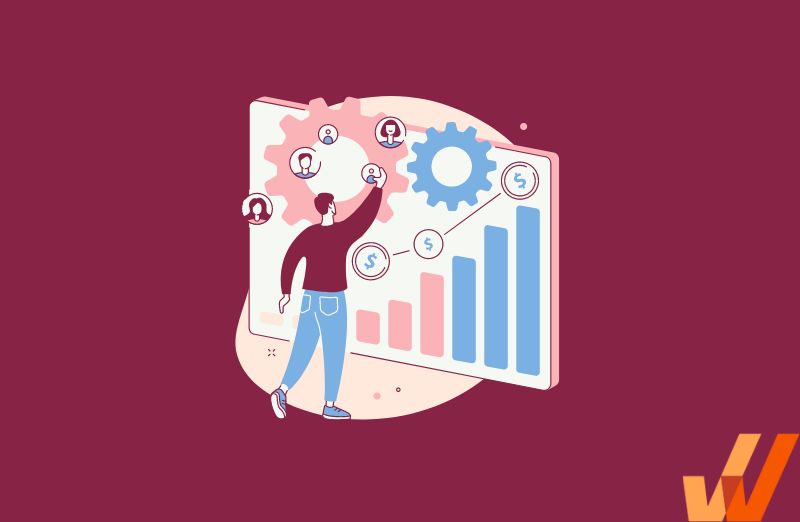
Andrew Dennis


When a company undergoes a digital transformation, it brings in new tools, technologies, and systems to improve efficiency, enhance processes, and create better customer experiences.
But taking on a digital transformation initiative is complex — especially without a proper plan in place.
A digital transformation model can be used to help shape your approach to a digital transformation initiative.
Let’s dive into what a digital transformation model is, why it’s important, and how to choose the best model that works for your transformation plans.
A digital transformation model acts as a framework for building and implementing a digital transformation initiative. Think of it as an outline to start building your transformation roadmap.
Digital transformation models help you develop a clear strategy for integrating new technologies, introducing new practices, and overseeing new processes. Specific models focus on different elements, making it easy to customize and prioritize the long-term goals or metrics that are most important to you.
Digital transformation projects are difficult to navigate — but when you try to implement massive changes across your entire enterprise without a plan, it’s a recipe for disaster. A successful digital transformation requires strategy and planning.
Digital transformation models are your first step in building a plan for success. Working from a model allows you to:
Here are ten types of digital transformation models to consider.
A horizon-based model breaks the digital transformation initiative into phases, or “horizons.” Each horizon focuses on a specific timeframe, priorities, and objectives.
A horizon-based digital transformation model might audit and optimize existing technology and processes in Horizon 1, invest in emerging opportunities and enhance existing strengths in Horizon 2, and focus on future long-term growth in Horizon 3.
A capability maturity framework uses stages of maturity to determine where a company should focus its digital transformation efforts. Various areas within the organization, such as data utilization and technology adoption, are measured for disruption readiness to find the best opportunities for digital improvements.
A staged roadmap model is one of the most commonly used in digital transformations. It breaks down the initiative into sequential steps and stages, with each stage having a defined objective, milestone, and timeline. Each stage builds on work done in the previous step until the transformation is complete.
Business architecture frameworks are used to help organizations align digital transformation initiatives with larger business goals. The framework uses the organization’s architecture and capabilities to ensure digital solutions match process needs and enable valuable innovation.
Taxonomy-based models use classification systems to categorize, organize, and prioritize digital transformation initiatives. Organizations can use the various categories to determine what should be implemented first and the overall impact each initiative might have.
A strategic pillar model uses core areas of focus to shape a digital transformation journey. Each pillar represents a critical component of the organization’s digital transformation goals, such as customer experience or workforce productivity.
Innovation and implementation strategies are then created considering each pillar individually and as part of the whole.
A lifecycle evolution model considers that digital transformation efforts should be iterative and ongoing to keep up with changing business needs. Rather than approaching transformation as a one-and-done effort, lifecycle evolution models go through stages of growth, optimization, and re-evaluation.
Component frameworks break down complex digital transformation processes into elements that are easier to manage and implement. Each element functions as a building block that can be worked on individually while still coming together to be a part of the larger goal.
Innovation-centric digital transformation models focus on creating a culture of experimentation and creativity. It encourages developing and integrating innovative processes, and identifying opportunities to use advanced and emerging technologies to stay optimized.
An agile and iterative approach to digital transformation prioritizes moving quickly to adapt to market changes. Using continuous feedback loops, the digital transformation journey is broken into smaller phases that can be adjusted, changed, and optimized to align with changing business requirements.
Here’s what those digital transformation models look like in action.
McKinsey’s Three Horizons of Growth is a horizon-based model that breaks a digital transformation into three key phases:
Gartner’s Digital Business Transformation Model helps identify new opportunities that come with innovation. These fall on a scale of “less transformative” to “more transformative”, including:
Boston Consulting Group’s digital transformation framework is a three-tiered approach to create short-term capital and fund sustainable performance. Here’s a breakdown:
The Six Stages of Digital Transformation is a digital maturity model that brings companies from “business as usual” to “innovative and adaptive.” Here are all six stages:
Agile digital transformation can be the most difficult to plan for — but it still requires embracing a systematic framework. The Agile Innovation Model uses five core principles to drive digital change:
Another digital transformation model from McKinsey, the Six Building Blocks breaks developing digital capabilities into six components of equal components. Those six building blocks are:
While each digital transformation model has pros and cons, not every framework will give you the same outcomes. Before choosing a digital transformation model, here are some factors to consider:
What is the ultimate goal of undergoing a digital transformation? How does this goal align with the company’s overall strategy and objectives? The model you choose should support these priorities and align with your overall digital transformation goals.
How much work needs to be done to get your organization where you want to be? How digitally mature is your organization pre-transformation, and what is your digital readiness? A more digitally immature company might need a more rigid framework.
Do you have the resources and budget available to support your digital transformation goals? Or, will you need to pace initiatives to align with budgeting objectives? Your chosen model should ensure the best return on your investments.
Larger, more complex company structures might require more effort to execute a digital transformation initiative. It can be hard for these types of organization structures to succeed with agile or other fast-moving models.
Does your industry have specific digital requirements or regulatory considerations? For example, pharma digital transformation will be much different than retail digital transformation. Another question to ask is, how digitally mature is your industry? The model you choose should work well with industry-specific factors.
Company culture and ability to handle change can greatly impact digital transformation success. Being unable to quickly adjust to and manage change might mean needing to choose a model that supports slower initiatives. A lack of a change management strategy could also indicate that your organization isn’t quite ready for a full digital transformation initiative.
Legacy application modernization is often one of the most complex parts of digital transformation. Your digital transformation model should support your cloud transformation journey away from any existing technology that no longer fits.
How quickly do you want your digital transformation journey completed? Are you looking to revolutionize your industry, or are you okay with moving at a slower pace? Make sure the model you choose matches your timeline goals.
Getting support from leaders, partners, and other stakeholders goes a long way in implementing a successful digital transformation plan. If you need to work on getting buy-in from these groups, your chosen digital transformation roadmap should reflect that.
Each digital transformation model comes with its own set of risks and challenges. Determine how much risk your company can manage, as well as any external challenges that may interfere with your digital transformation implementation.
With a digital adoption platform like Whatfix, enable your employees with in-app guidance and contextual self-help IT support to accelerate the adoption of new software implementations, employee onboarding, change initiates, and more. Whatfix’s no-code editor enables IT teams with a no-code editor to create product tours, interactive walkthroughs, task lists, smart tips, pop-ups, self-help wikis, and more. Analyze and measure user engagement and software usage to identify friction points, measure digital adoption, and improve employee digital experiences.
Some of the world’s biggest companies have used models to support their digital transformation journeys. Here are some of their stories:
In an effort to position itself as a cloud computing and digital services leader, Microsoft underwent a digital transformation journey. Through this process, they moved away from traditional software models and prioritized digital services, software-as-a-service tools, and cloud computing.
Nike used digital transformation models to build their digital ecosystem, including e-commerce platforms, apps, and seamless, personalized shopping experiences. Using their app, Nike delivers products directly to consumers and can use data and analytics to offer personalized experiences and recommendations.
Domino’s created better user experiences with digital transformation models, including creating a better way to order. In addition to online and app ordering, Domino’s introduced AI chatbots to take orders, track deliveries, and provide support, and even added voice-activated ordering to voice-controlled devices.
Walmart expanded its e-commerce presence using digital transformation models. It now uses an omnichannel strategy to deliver a seamless shopping experience between online and in-store, and even on its mobile app.
Adobe moved away from just selling traditional software to becoming a customer-focused, experience-based provider. With digital transformation models, Adobe adopted a subscription-based product model and cloud-based offering, including mobile-friendly tools with touch interfaces.
No matter the digital transformation model you choose, you’ll need a platform to support your team through the upcoming changes.
With a digital adoption platform (DAP) like Whatfix, you accelerate your digital transformation journey by enabling your employees with in-app guided experiences to drive change and achieve adoption, proactively support end-users directly in your applications with self-help support and nudges, and analyze your application adoption and user experiences with behavior analytics.

Thank you for subscribing!